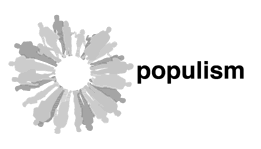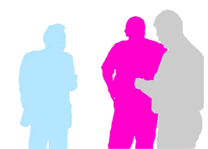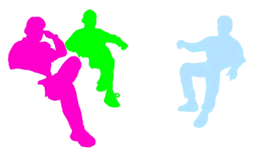Matthieu Laurette
Matthieu Laurette plays with the systems of commodity exchange and celebrity, and the marketing strategies through which they operate. It all started with television, or rather on television, with Laurette as a participant on a game show. When the host asked Laurette about his future plans in front of the rolling cameras, he answered that he wanted to become a multimedia artist. Between the recording and the broadcasting of the show, Laurette then sent out invitations to view the show, turning his staging of the artist into a performed reality. Since then, Laurette has been an audience member or guest on many a TV show, using the televisual footage as material for his own practice. He feeds these seemingly anonymous pictures of the artist back as interruptions into the image flows of public and semi-public spaces, of galleries and commercial display boards alike.
Laurette organises look-alike conventions in the contexts of his exhibitions, too, and the protagonists oscillate in a similar way between being sad copies and incorporating the possibility of playfully appropriating existing images. Yet it is his citizenship project (Wanted: Financial Support to Acquire Citizenships) that pushes (im)possible forms of appropriation to their extreme legal dimension when Laurette attempts to acquire as many nationalities as possible, asking for donations as well as legal advice and practical support through oversized donation boxes. At the Venice Biennale, he offered non-represented countries national participation in the exhibition in exchange for the country granting him citizenship. As a point of departure and material for the work, the secondary and minor allow Laurette to undercut even the seemingly total configurations of nationhood.
This quality also provides the starting point for the series of money-back and exchange projects through which Laurette managed to live virtually for free by exclusively buying goods with satisfaction guaranties. Having purchased the goods, he would state that he was not 100% satisfied with them and have the full purchase price refunded to him by the respective manufacturer.
Of course the money-back guarantee only works because very few people actually make use of it. When Laurette presents his method of dealing with consumer culture again and again, he quintessentially launches a thought experiment that demonstrates the structural limits of promised satisfaction. And in doing so, he tests these empty but legally binding promises to the extreme edges of their flexibility.
Laurette immerses himself in these processes instead of simply criticising them, and allows for everything to feed back into the work. Even when the press starts reporting on his projects, this very reporting is integrated back into the work as part of its material. Monumentalised, the reports become the background for a work that looks itself like a trade show display. What is displayed, though, are not goods but an artistic allegorisation that appropriates these marketing strategies only in order to unhinge their underlying assumptions about value and appropriateness.
By Edgar Schmitz
"Moneyback Life ! Mobile Information for Moneyback Products (version #2)" (2001)
(Life size wax sculture, shopping cart filled with moneyback products, 9 television sets...
Variable dimensions.) Courtesy Deweer Art Gallery, Otegem, Belgium.
"Déjà vu : The second International Lookalike Convention at Castello di Rivoli" (October 10, 2001) (Event view) Courtesy : Matthieu Laurette and Yvon Lambert, Paris.
|









